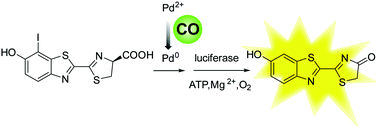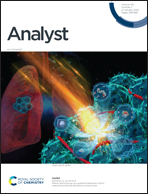Bioluminescence imaging of carbon monoxide in living cells based on a selective deiodination reaction†
Abstract
D-Luciferin is a popular bioluminescent substrate of luciferase in the presence of ATP. It is used in luciferase-based bioluminescence imaging and cell-based high-throughput screening applications. Herein, the iodination of D-luciferin was undertaken and explored as a bioluminescence probe without the need for light excitation to sensitively trace and image carbon monoxide (CO) in liver cancer cells. The bioluminescent probe (7′-iodo-luciferin) exhibited excellent selectivity for CO detection in vitro. This new probe could image exogenous and endogenous CO in the luciferase-transfected cancer cells. This new probe might be used for evaluating the roles of CO in various biological processes.



 Please wait while we load your content...
Please wait while we load your content...